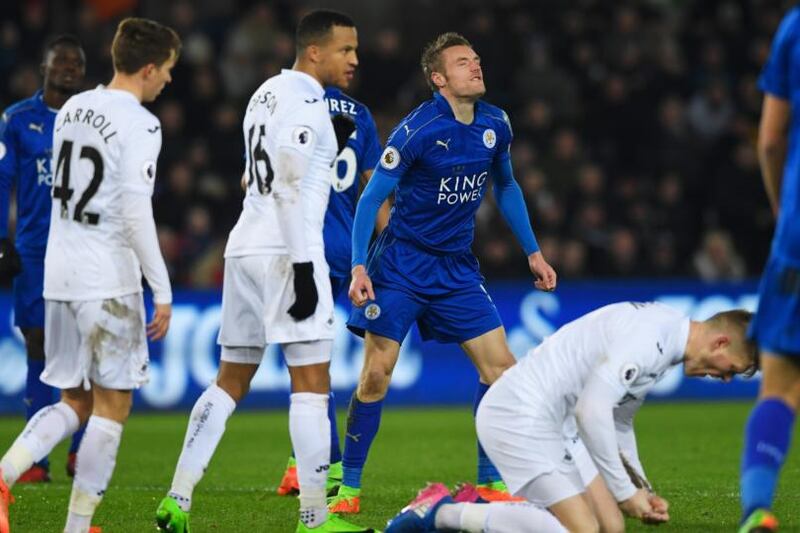In Brilliant Orange: The Neurotic Genius of Dutch Football (2000), author David Winner meets the photographer Hans van der Meer, who was known in the Netherlands for his unorthodox approach to match photography.
He had no interest in the sort of close-up action shots most of us associate with football coverage. Instead, he positioned himself high in the stands, so that he could fit a large area of the pitch in his frame, and tried to capture particular pivotal moments in the game.
“There are one or two moments when a situation develops and you understand something will happen,” van der Meer explained. “This is the moment of tension, of possibility. This is what I look for.”
The idea of the "moment of tension" is illustrated with two photographs from Ajax matches of the mid-90s. The first is from a 1995 Eredivisie match against Groningen. Ajax are about to spring forward on the attack; the second striker, Jari Litmanen, has the ball in a pocket of space behind the Groningen midfield, with the forwards Marc Overmars, Patrick Kluivert and Finidi George bursting through the retreating Groningen back line. It's a picture of a machine in perfect harmony.
The second picture is from Ajax's 2-1 home defeat to Juventus in the 1997 Champions League semi-final. Zinedine Zidane is advancing on the Ajax D, there are two Ajax defenders in front of him with the rest of them marooned up the pitch. Zidane can pass left to Attilio Lombardo, or right to Pippo Inzaghi or Christian Vieri, it's a four-on-two, Juventus have outflanked Ajax on both sides, a goal looks certain.
Actually Juventus didn’t score from that move. But the photograph captured Ajax’s tactical collapse more eloquently than any match report. It illustrated the breakdown of a system and the end of a team.
Stunning victory
Van der Meer would have had fun at the Parc des Princes last Tuesday night. The second, third and fourth Paris goals in their stunning victory over Barcelona were all preceded by such "moments of tension". For the second, Rabiot robbed Messi; for the third, Matuidi played Kurzawa past Busquets; in both cases a scoring chance immediately looked on. The extraordinary nature of the match was summed up by PSG's disbelieving right-back, Thomas Meunier: "For the [fourth] goal I ran through 50 metres of space without being tackled. I asked myself, how is this possible?"
The saddest sight of the night was Andrés Iniesta gamely sprinting 50 metres to challenge Ángel Di María on the third Paris goal, only to arrive so exhausted that he was brushed aside like a balloon by the skinny Argentine.
When Iniesta has to sprint 50 metres in a straight line, you know that something has gone horribly wrong. It’s tempting to watch that move and conclude that Iniesta is 32, he’s had too many injuries, his legs are gone. But Iniesta has never been a box-to-box dynamo. If he had spent his career in teams that required him to run 50 metres on a regular basis, most of us would never have heard of him.
The Barcelona of six or seven years ago could never have suffered a defeat like last Tuesday’s. Kurzawa and Meunier could never have run unopposed through the middle of the pitch. For Guardiola, control of the centre was non-negotiable.
Guardiola understood how systems can make or break players, because his own success as a player depended on the system. Johan Cruyff wrote in his autobiography: ". . . at Barcelona, they wanted to get rid of Pep because he was a lanky beanpole who couldn't defend, who had no strength and couldn't do anything in the air."
Defensive midfielder
Guardiola had been a creative midfielder in the youth system but Cruyff told him he saw him as a defensive midfielder. Guardiola was doubtful – surely his lack of speed and strength would see him horribly exposed? Cruyff explained that anyone could defend if he only had to defend a zone of a few metres’ radius. Guardiola’s defensive task would not be to chase attackers all over the pitch. It would be to stay in his central zone and intercept any balls played through the middle. The beanpole who couldn’t run ended up running Barcelona’s midfield for a decade.
The man who has occupied Guardiola's old position since 2008 is Sergio Busquets, who is just like his old coach: a brilliant passer and reader of the game who can't run. In the old, compact Barcelona system, he didn't have to run: there were always team-mates close at hand. In tight spaces, there is nobody better than Busquets. When the game is stretched, he might as well be a telephone pole. On Tuesday in Paris, the game was stretched.
Luis Enrique was a different kind of player from Guardiola or Busquets. He was a warrior, a fireball, a natural athlete whose pride was that he could play in every outfield position. He would have succeeded in any system, at any club. He had no real weaknesses, and so he never had to think very hard about how tactical systems can compensate for – or expose – individual weaknesses. The tactical set-up he devised for the game against Paris might have worked if Barcelona had a team of 11 Luis Enriques, but it was no good for Iniesta and Busquets.
For their next coach, Barcelona need someone who understands how the wrong system can make even the best players look bad.
















